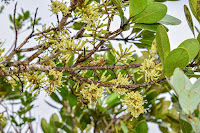 |
| Helicia danlagunzadii Malabrigo, Eduarte, A.G. Umali, A.B.Tobias & Navidad, in Malabrigo, Umali, Eduarte, Navidad & Tobias, 2023. |
A new species, Helicia danlagunzadii, from the mossy forest of the Mt. Mantalingahan Protected Landscape (MMPL) in southern Palawan, Philippines is described and illustrated. The new species is distinct from the other known species of Helicia in the Philippines because of its ramiflorous flowering, very short inflorescences (less than 4 cm), and yellow color. Helicia danlagunzadii is the sixth species of the genus recorded in the Philippines. Following the assessment criteria of IUCN, the species is assessed as Critically Endangered.
Keywords: critically endangered, endemic, Malesian Flora, ramiflorous, short flower
Helicia danlagunzadii Malabrigo, Eduarte, A.G. Umali, A.B.Tobias & Navidad sp. nov.
Diagnosis – Helicia danlagunzadii sp. nov can be easily distinguished from other Helicia by its very short inflorescences (2.5–3.5 cm) that are almost completely hidden among its leaves. Helicia species in the Philippines and in other countries – particularly in Malaysia, New Guinea, and Australia – have longer inflorescences ranging from 4–32 cm (Chung 1998; Foreman 1995, 1998; Weston 1995). Among the 114 accepted Helicia species, only H. microneura and H. microphylla have inflorescence shorter than 7 cm. However, the new species differs from H. microneura with its much smaller leaves with entire venation (toothed on the upper part of the leaf on H. microneura), slightly prominent midrib above, and shorter petiole (midrib flat above with 2–3 mm petiole length on H. microneura). Similarly, the new species differs from H. microphylla by its slightly prominent midrib above (midrib impressed above in H. microphylla), ramiflorous inflorescences (axillary in H. microphylla), and shorter perianth (perianth 14–17 mm in H. microphylla). Of the Helicia species in the Philippines, H. danlagunzadii sp. nov. is closely allied to H. loranthoides Presl, with their relatively similar leaf shape and perianth length. However, H. danlagunzadii has smaller leaves and shorter, glabrous flowers, where pubescence was observed to be only present in the pedicels, as opposed to the completely pubescent flowers of H. loranthoides. These combined characters distinguish H. danlagunzadii sp. nov as a new species. For better distinction of Helicia species in the Philippines, a dichotomous key is provided below, whereas the comparison of morphological and ecological characteristics are presented in Tables 1 and 2, respectively.
Etymology – The species epithet danlagunzadii is a commemorative name in honor of the great Filipino systematist and ecologist, Dr. Daniel A. Lagunzad, who served as the first author’s mentor. Dr. Lagunzad worked as a Professor at the Institute of Biology, University of the Philippines Diliman. His passion and interest in native plants inspired many of his students to pursue the very challenging field of taxonomy. He was the best doctor to cure plant blindness among his students.
Pastor L. Malabrigo Jr., Arthur Glenn A. Umali, Gerald T. Eduarte,
John Ryan L. Navidad and Adriane B. Tobias. 2023. Helicia danlagunzadii (Proteaceae), A New Species
from the Mt. Mantalingahan Protected
Landscape, Palawan, Philippines. Philippine Journal of Science. 152 (2): 581-589.
https://philjournalsci.dost.gov.ph/images/pdf/pjs_pdf/vol152no2/helicia_danlagunzad_a_new_species_from_Mt_Mantalingan_Palawan_.pdf



